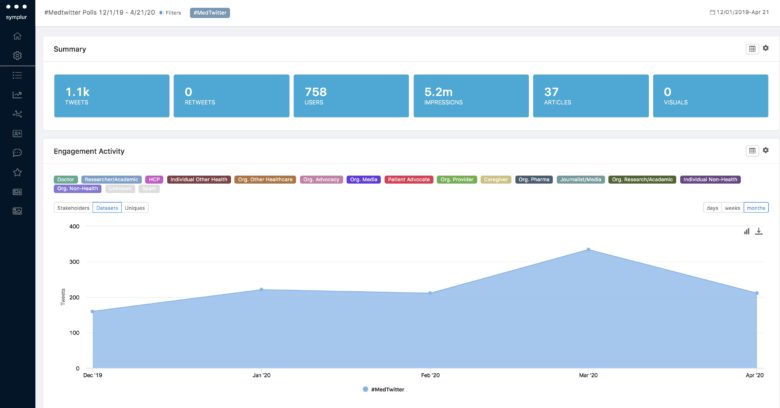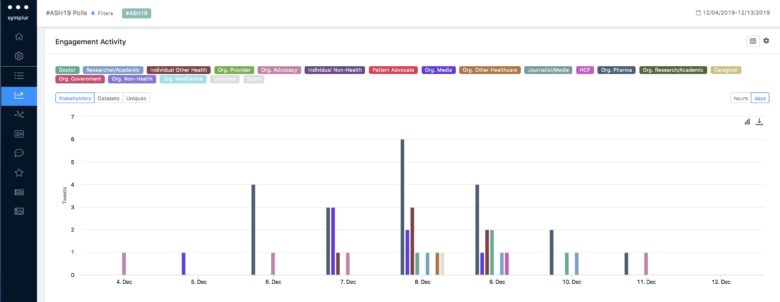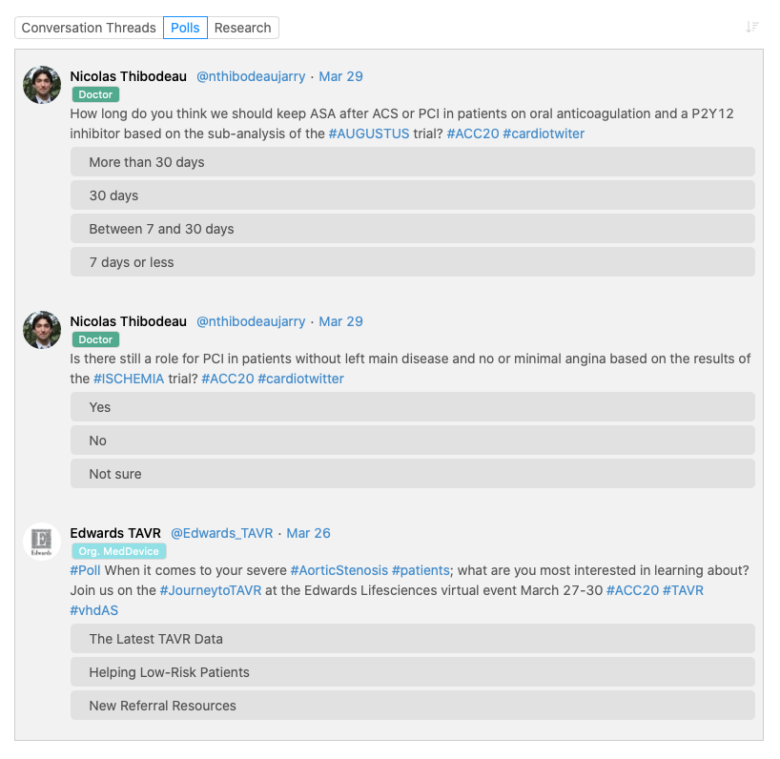Since Twitter Polls launched in 2015, they’ve been hailed by marketing and social media strategists as an almost frictionless tool for brands to use to humanize themselves, listen to and interact with their audience, drive engagement, generate buzz, and more.
In the healthcare social media and #MedTwitter world, however, we’ve seen a trend of clinicians using them to solicit opinions and exchange and discuss best practices. Since the beginning of December 2019, the Symplur Signals Polls Filter applied to the #MedTwitter dataset alone shows there have been 1100 tweets containing polls.

We’ve also seen medical conference participants including clinicians, advocacy organizations, pharmaceutical and medical device companies, and media use polls to crowdsource insights, gauge reactions to practice changing trials, and more. Last December, we counted 44 polls during the American Society of Hematology’s #ASH19.

And at the recent World Congress of Cardiology’s #ACC20, which was held as a virtual event due to COVID-19, we found 10 tweets with polls via the Polls Filter (compared to none for 2019), including the following:

Twitter Polls and COVID-19: Accelerating Knowledge Transfer
In the context of the global COVID-19 pandemic, with countries and counties further ahead than others — for better or for worse — in their handling of the virus, the ability to turn to trusted professional networks to rapidly ask and answer questions and share experiences and data can be a game changer. Twitter polls are a quick, easy, and public way to gather information and transfer knowledge back and forth across time zones and even languages. They create a digital footprint, work faster than surveys, provide a level of anonymity to respondents (Twitter doesn’t publish how people vote), and are very often useful as conversation starters.
That being said, polls are a rough way to gather data and are far from scientific. For one, there is no guarantee that respondents belong to the cohort you think you are reaching out to. Therefore, they are to be taken with healthy grains of salt. Communication scholar, Ozan Kuru, Ph.D. wrote about these downsides, particularly as they relate to political polls, and offered that at minimum “Twitter should consider, or at least pilot, a warning label for polls.”
Several factors can help in adding context and insight to polls, including the level of twitter conversation that ensues in the replies (provided that people reply directly and/or that they use a common hashtag as in a tweetchat, for example.)
I singled out several interesting and noteworthy uses of polls and interviewed their authors. Responses were lightly edited for clarity.
Haunting PPE Poll Gets Top Engagement
On March 13, 2020, Purvi Parwani, MD launched a Twitter poll that received the highest engagement for that week (Symplur Signals subscribers who have access to the necessary datasets can view and interact with this dashboard). With hindsight, her question is all the more haunting, given the continued deficits in Personal Protective Equipment (PPE) for healthcare personnel.
When I asked Parwani about her experience creating Twitter polls she replied:
“It’s easy to create polls, they are a quick way to assess the thoughts crowds may have without anyone expressing or justifying their thought process.”
Regarding what inspired her to create this particular poll, Parwani noted: “This was in the early phase of COVID-19, I was on consult service in a county hospital because one of my colleagues had called in sick and almost every patient I had seen was coughing. There was no hospital policy and I was asked why I was wearing a mask. I was curious to know what everyone else thought regarding how to protect ourselves—given community transmission, lack of testing, and symptomatic patients.
Parwani shared what she learned from the poll: “Almost 67% of the participants suggested that they would wear a mask. It was important for me to know what the rest of the physicians thought. Was I really paranoid by wearing the mask? It was clear from the poll the physicians across the country were worried about the same. Some of them were given one mask only, with expectations to wear the same mask again.”
A few weeks after her poll’s responses came in, I asked Parwani if she had any further thoughts on its results. She replied: “Now looking at that poll, it was clear that all of us were thinking way ahead. All those concerns from physicians across the country were valid.”
Testing and Asymptomatic Spreading in Healthcare — a Poll
Another important COVID-19 topic is testing and asymptomatic spreading. Matthew Katz, MD used this Twitter poll to address it on March 29, 2020:
With fewer healthcare workers tested, there is the risk of asymptomatic workers becoming super-spreaders to sick patients. So the U.S. curves may still spike once we test more.
— Matthew Katz, MD (@subatomicdoc) March 29, 2020
For U.S. healthcare workers, have you been tested for #COVID19?
When I asked him what motivated him to use this format to gather information, whom he hoped to reach, and what he hoped to learn from it, his reply was:
“I am trying to help ensure my colleagues in emergency medicine, internal medicine and critical care have what they need for the coming surge. I had a previous discussion of helping get PPE access. Next was trying to use a poll to gauge how many healthcare professionals still don’t know if they’re infected or safe to care for their patients.
My hope is to help get doctors, EMTs, nurses, and therapists tested for the benefit of them and patients alike. A large poll may be worth sharing and draw some attention from media to reinforce a quantitative problem that could be resolved with testing.”
In a designed-to-be-provocative follow up question, I asked Katz why he didn’t simply contact all the physicians he knew by phone or email to ask them this question. He replied:
“A Twitter poll is public domain and easy to share with the media. My connections with doctors in other specialties are broader online as well, making this a better fit.”
An Innovative Combination: Twitter Polls Inside a TweetChat
The Thoracic Surgery Social Media Network (#TSSMN) convenes tweetchats throughout the year, among other things. Given the impact of COVID-19 on their specialty, chat co-hosts Mara Antonoff, MD and Jessica G. Y. Luc, MD recently pivoted from their usual manuscript discussion format to focus on supporting cardiothoracic surgeons in the pandemic.
Antonoff and Luc made the deliberate choice to use polls in the chat, given in part, the potentially controversial aspects of some of the topics with the strain of COVID-19 on the healthcare system. These include treatment recommendations for patients with left main coronary artery disease, those with severe symptomatic valvular disease, and whether heart or lung transplants should be put on hold. After explaining that the poll questions, none of which had clearcut responses, were crowdsourced within the #TSSMN community ahead of the chat, Luc elaborated:
“The polls were meant to ask potentially controversial questions in an anonymous fashion and allow individuals who answer them to obtain immediate feedback by being able to see the responses of others — this is important in a time like COVID-19 when we don’t have all the answers to the questions, and are seeking peer consensus and discussion of practice patterns and opinions as we navigate these uncharted waters together. Another benefit of Twitter polls is that you can do it synchronously and asynchronously and people around the world can still contribute after the tweetchat hour is up.”
Antonoff added: “We recognized that participants in the chat may be interested in others’ opinions, and that they may have valuable input to share. In many circumstances, people participate in chats but may not feel particularly “vocal” in terms of crafting their own tweets. A poll is an effective means for a greater number of participants to share their voice without fear of being redundant of another tweet on the same chat.”
According to Luc, an additional benefit of using Twitter polls instead of a standard survey, for instance, is the ability to see results in real time: “The heart/lung transplant poll initially came in at an almost 50-50 split in votes. We were able to highlight that during the tweetchat and ask more people to weigh in by either completing the poll or commenting below in the replies.”
Both concluded that using polls within the tweetchat was a valuable innovation. Antonoff was “surprised at how many more people answered the polls than tweeted qualitative comments, verifying the idea that many individuals may feel more comfortable responding to a multiple choice question rather than writing a tweet de novo.” And Luc said she “was able to gain insight from my colleagues worldwide on controversial topics and spark discussion in the context of posing these controversial questions.”
Both Antonoff and Luc are enthusiastic about the possibilities of using Twitter polls within tweetchats. Antonoff concluded: “Do it! It’s super informative and stimulates discussion.” And Luc offered the following tips: “I would advise people to do polls within Twitter threads so that the audience can easily glance through one thread to answer all polls rather than have to scroll through the entire chat to find them. I would also advise people to use Thread Reader for even easier viewing as we did here.”
When asked about the potential downsides of Twitter polls, Luc noted that there are no guarantees that all participants will respond to each poll: “One of our polls had only 15 respondents while another had about 100. This makes it hard to analyze data. And you might have response bias.”
However, she concluded, polls are an “effective modality to stimulate discussion and have people give their honest opinions in a documented fashion.” Echoing Katz about the power of Twitter to reach beyond the usual silos, Luc added that these tools “allow you to move beyond your community, and educate the larger medical and patient communities,” noting that “for cardiothoracic surgical patients being told their surgeries will be postponed due to COVID-19, it’s important for them to be able to see the crowdsourced consensus of cardiothoracic surgeon practice patterns across the globe, as well as discussion regarding the considerations for those decisions.”
Subsequent to our interview, Luc, Antonoff, and team gathered their findings about the chat and wrote an editorial for the Annals of Thoracic Surgery.
Powerful Tool
Innovative and creative uses of Twitter polls in the medical community are showing they are a powerful tool for easy and rapid information exchange, especially when used thoughtfully.
